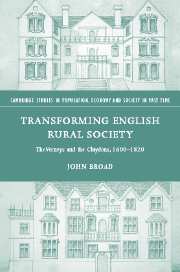Book contents
- Frontmatter
- Contents
- List of figures
- List of tables
- Preface
- Acknowledgements
- Note on editorial practice
- List of abbreviations
- 1 Introduction
- Part I Re-establishing a gentry family 1600–1657
- 2 A gentry family in county and court society 1603–1642
- 3 The Civil War and Interregnum 1642–1657
- 4 The creation of an enclosed estate 1600–1657
- Part II The shaping of family and village 1657–1740
- Part III The great estate and estate communities c. 1700–1820
- Appendix A Sir Ralph Verney's confessional letter of 1650
- Appendix B The genealogy of the Verney family
- Bibliography
- Index
2 - A gentry family in county and court society 1603–1642
Published online by Cambridge University Press: 03 July 2009
- Frontmatter
- Contents
- List of figures
- List of tables
- Preface
- Acknowledgements
- Note on editorial practice
- List of abbreviations
- 1 Introduction
- Part I Re-establishing a gentry family 1600–1657
- 2 A gentry family in county and court society 1603–1642
- 3 The Civil War and Interregnum 1642–1657
- 4 The creation of an enclosed estate 1600–1657
- Part II The shaping of family and village 1657–1740
- Part III The great estate and estate communities c. 1700–1820
- Appendix A Sir Ralph Verney's confessional letter of 1650
- Appendix B The genealogy of the Verney family
- Bibliography
- Index
Summary
The Verneys established their country seat at Middle Claydon in north Buckinghamshire in 1620. They had ancient connections in the county, but only after crucial events in the first two decades of the seventeenth century did they make Claydon their county residence, taking over the existing large manor house in a parish where they were manorial lords. Over the next fifty years they consolidated their estates in the immediate neighbourhood, and then expanded them until in the third quarter of the eighteenth century they vied with the Grenvilles of Stowe and Wotton Underwood for landed and political pre-eminence in the northern or ‘Vale’ part of the county.
The Verney family can be traced back to around 1200, and by 1230 they had established links in the Vale of Aylesbury. By a marriage alliance they acquired Fleet Marston, some eight miles from Middle Claydon, and close to Aylesbury. It came to be their country residence for some 200 years. However, in the fifteenth century the family moved to London and made vital connections in both city and court circles just as they were to do in the seventeenth century. One Ralph Verney was a London mercer who progressed through city offices to become sheriff in 1456, mayor in 1465, and was knighted and represented the City in the parliament of 1472. His son John married into another city family, the Whittinghams, whose estate and house at Pendley near Tring became the family seat for over a hundred years.
- Type
- Chapter
- Information
- Transforming English Rural SocietyThe Verneys and the Claydons, 1600–1820, pp. 15 - 26Publisher: Cambridge University PressPrint publication year: 2004

